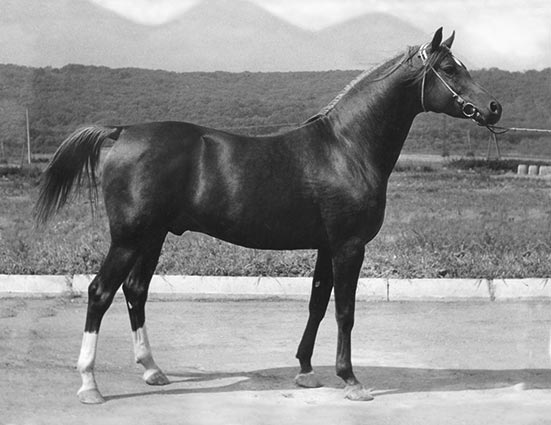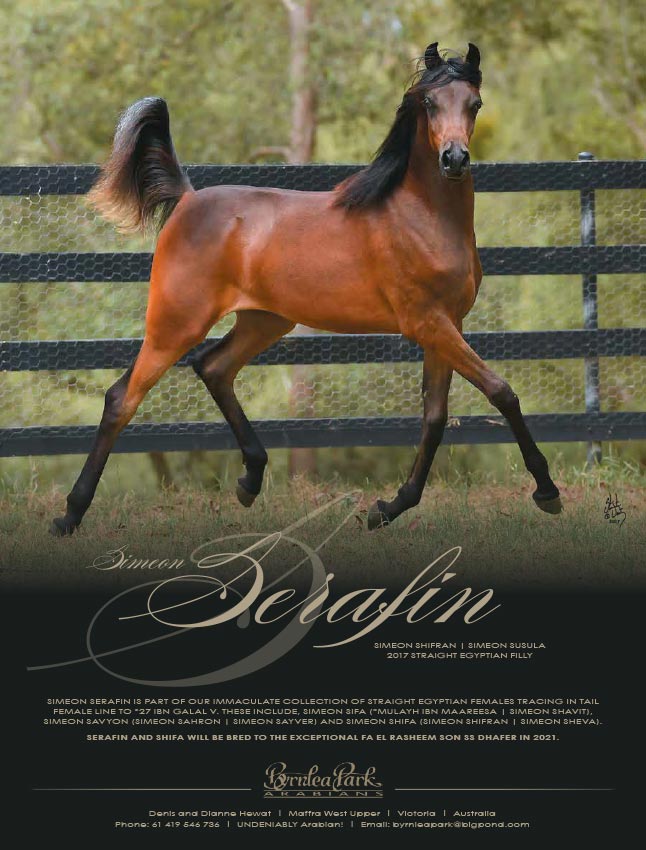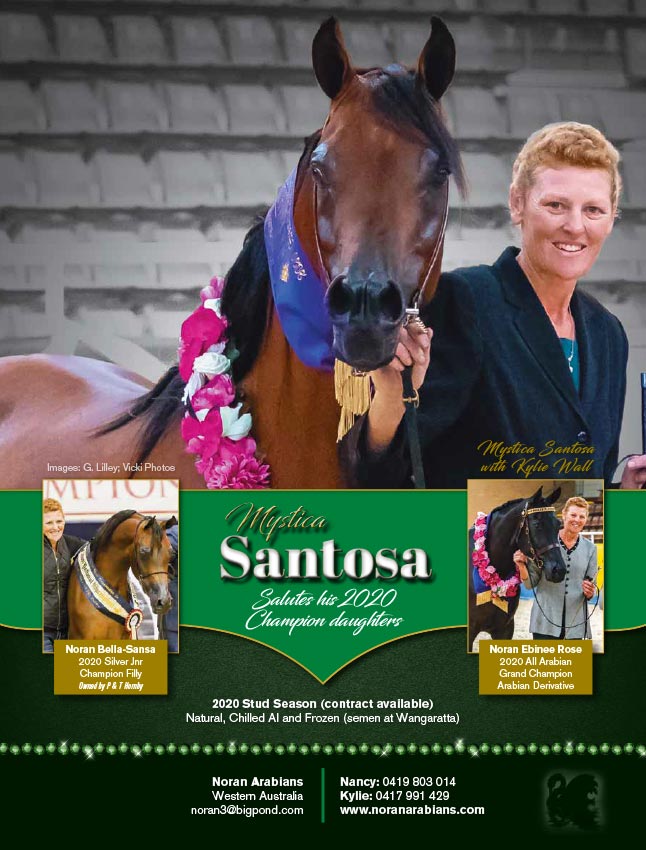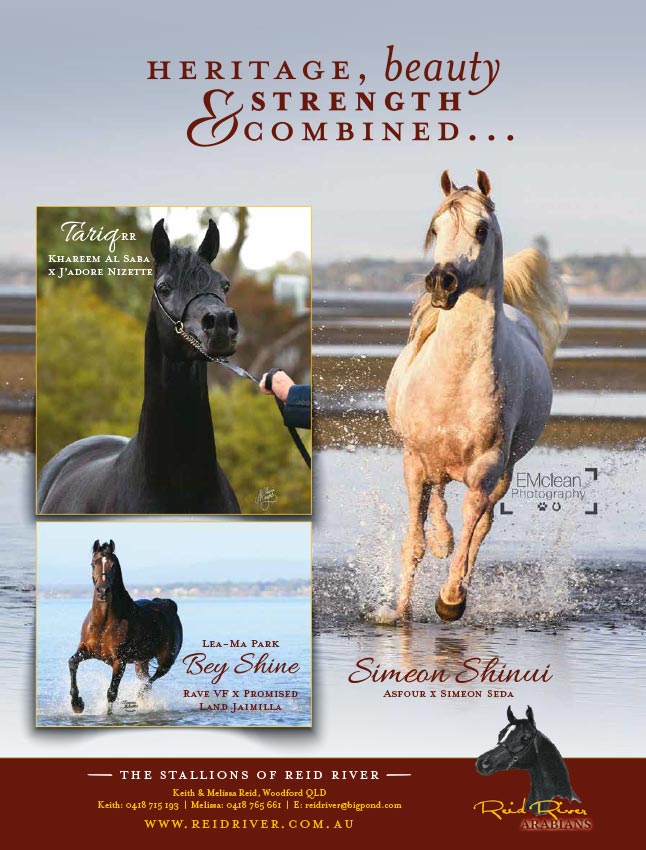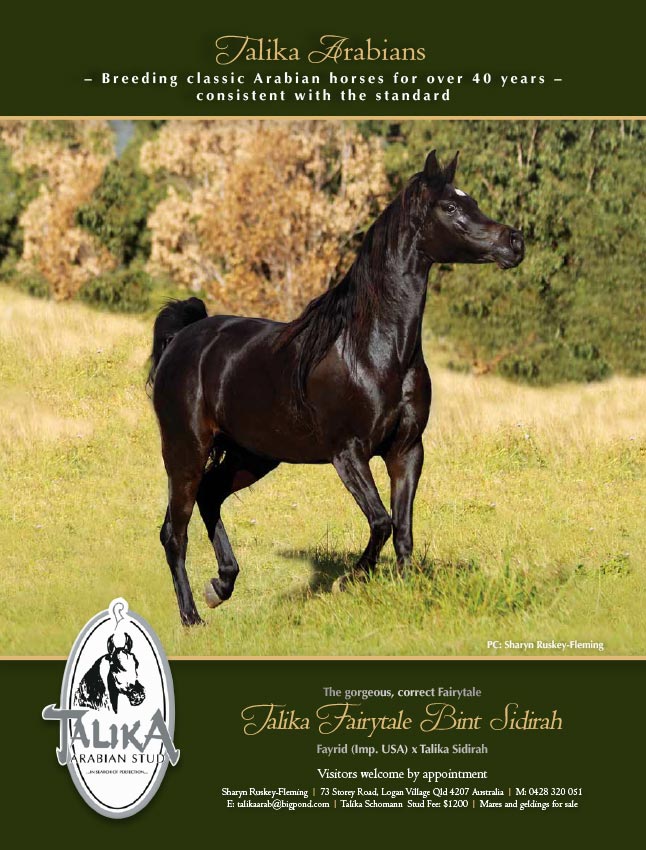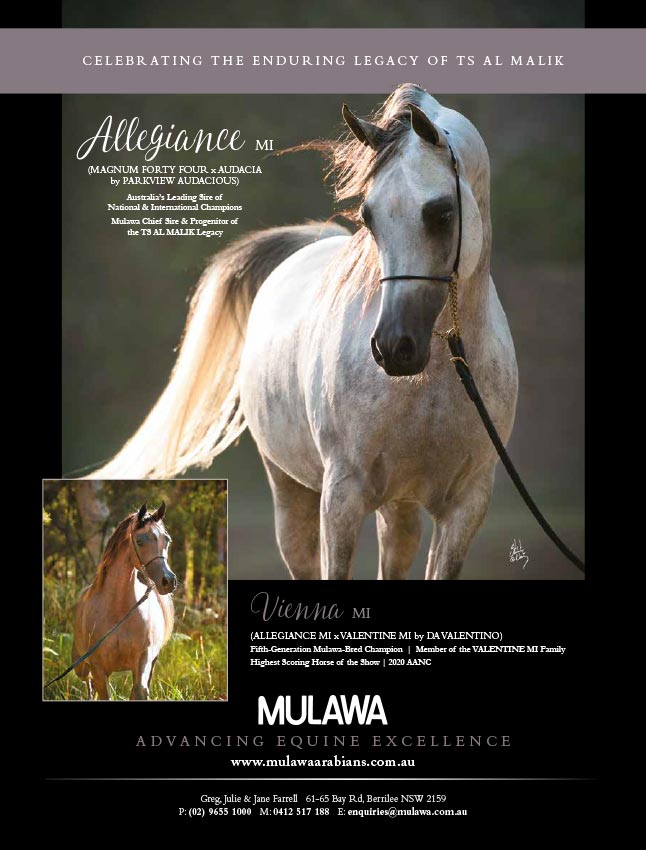Bairaktar

Andres Castano
August 28, 2020
Swiftwood Arabians
August 31, 2020Bairaktar
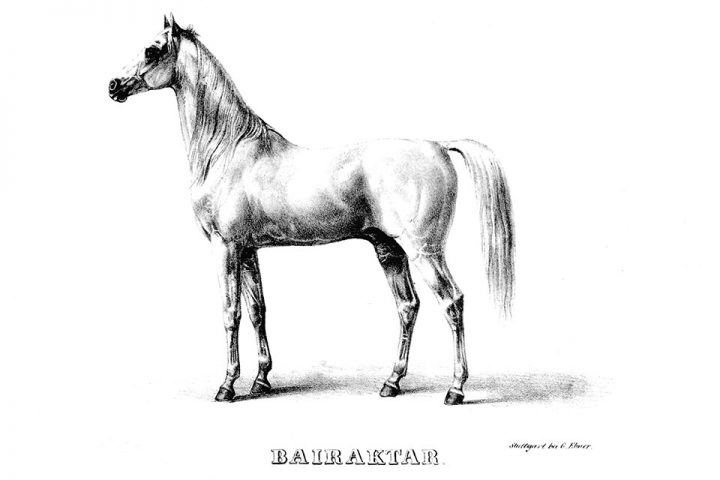
Bairaktar was the crown of the stud, a magnificent animal, whose progeny is unequalled
BY GUDRUN WAIDITSCHKA
‘There are only very few Arabian stallions which have had an influence on horse breeding as lasting as the desertbred stallion Bairaktar, imported 1817 for the Royal Private Stud of Weil-Scharnhausen. He was imported from the Orient just over 200 years ago and not only did he have a worldwide influence on Arab horse breeding since then, but his blood is also an integral part of modern sports horse breeding.’
In May 1817, even before King William I. of Württemberg founded his Royal Private Stud of Weil, Scharnhausen and Klein-Hohenheim by decree on 30th September, the two stallions Bairaktar Or.Ar. and Tajar Or.Ar. were imported by Baron [Duke] von Fechtig and arrived at Stuttgart. Both stallions were of the Saklawi Djedran strain, and von Fechtig had purchased them through a middleman in Syria. This middleman was a veterinarian, who came with Napoleon’s French army to Egypt, and stayed in the Orient. It is written that he travelled ‘from Aleppo and Damascus to the interior of Arabia, inhabited by Arab tribes, to purchase Arab stallions and mares of pure blood.’ The two stallions for Weil cost a fortune – von Fechtig asked for 4.500 Imperial ducats, payable in five installments. This was at the time more than 25.000 Gulden, which corresponded to the annual budget of the Royal Stud, designed for 165 horses; today, 4.500 Imperial ducats would have a gold value of around $750,000AUD.


BAIRAKTAR’S BREEDING PERFORMANCE IN WEIL
In the beginning, preference was given to Tajar Or.Ar. as a sire. However, after a group of desertbred mares had arrived, imported by Count Rzewuski in 1819, Bairaktar Or.Ar. would prove his worth as a sire. ‘Bairaktar was the crown of the stud, a magnificent animal, whose progeny is unequalled. The King used him for some time as his personal mount, as his value as a sire was not yet fully proven; but once we were convinced about it, he was used solely as sire and was kept as long as his strength would allow’, was written posthumously about the stallion. From a breeder’s perspective, Bairaktar was unsurpassed and a stroke of luck for Weil, which resonated for a long time. He served as chief sire in the years 1825 to 1838, covering about 10 to 15 mares each year, mostly Arabian mares, but also Persians; this branch of the breeding program (pure Persian and Persian-Arabian) was maintained until the 1850s, then it was terminated. Of the 200 mares he covered, about 110 purebred Arabian foals were born, of which there were 45 colts, the rest fillies.
Among his sons, three distinguished themselves: Amurath I 1829, Bairaktar II 1836 and Mazud 1838. In the first place, Amurath I 1829 needs to be mentioned, who even exceeded his sire in quality and was the most noble and most perfect purebred Arabian of his time. ‘Amurath, son of Bairaktar, grey stallion, 16 Faust (Württemberg measurement, i.e. 152 cm) high, of strong bone and noble forms. He is a noble animal, formerly the riding horse of the King, now only used as sire. Although he often serves unwilling and sullen, he is nevertheless a good reproducer and produces descendants worthy of him. ... The stallion Bairaktar (II), son of the famous Bairaktar, also grey, measures 15 Faust, 2 inches (147 cm) and is just like Amurath bred by the Royal Stud... A third sire of our own breeding is the five-year-old grey stallion Mazud, a magnificent animal, a true ideal of a noble horse, but only 14 Faust 2 inches high (138 cm). The strictest hippologist would not find any blemish on this stallion, except for his size. All of him is in beautiful harmony, everything is beautiful, noble and graceful, at the same time his fire, his vitality, the beautiful head with those intelligent, bright eyes, the unsurpassable formation of the neck, the withers, the croup, the shoulder and the legs, the beautiful shiny silk-like hair, the long dark mane and the full tail, carried high – truly, any painter, any sculptor could choose this delightful stallion (for whom, it is said, 20.000 Gulden have been offered) as a model for the most noble horse. What the offspring of this excellent stallion will be like, remains to be seen, he covers this year for the first time... The mentioned stallions are the most distinguished of the Arabian breed and used for breeding purebred Arabians.’
Furthermore, the experts at the time agreed: ‘These stallions are striking proof of the quality of the offspring from purebred Arabian breeding and how even in our climate this noble breed cannot only be bred on, without losing its characteristics, but could get even more perfected according to our requirements and intended uses.’ Apart from the three mentioned stallions, several other sons of Bairaktar were also used for some time in the breeding barn: Kalif 1826, Selim II 1828, Aga 1832, Aleppo 1833 and Tajar 1836.

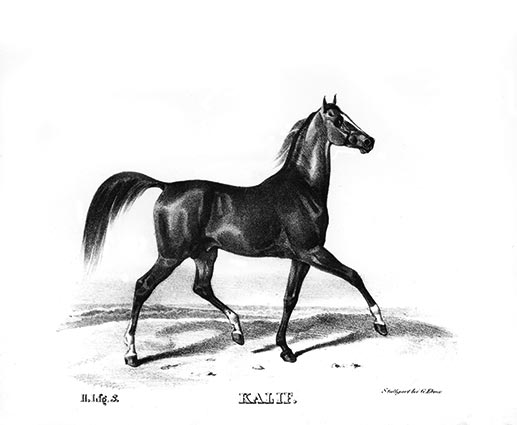
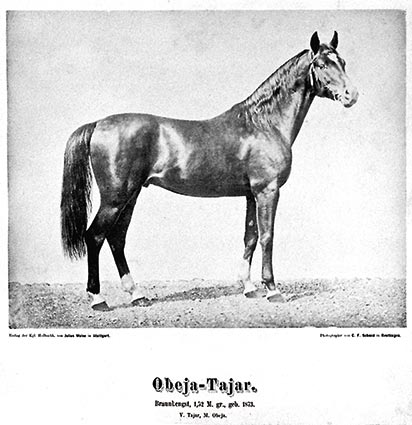
AMURATH I 1829 – EVEN BETTER THAN HIS SIRE
Despite the qualities of these stallions, as described above, and despite quite a significant number of offspring in second generation, it was only Amurath I 1829, who succeeded as a long-term progenitor of this sireline. His dam was Sady III 1821, who was born during her dam’s trip from Hungary to Germany. Her dam Hamdany Or.Ar. was, just like Bairaktar and Tajar, purchased by Baron von Fechtig, who imported her from the Orient. Von Fechtig stabled the horses, which arrived by ship in Trieste, Hungary, either at the stud of Count Hunyady at Ürmeny or at Bábolna. At this occasion, the mares were often covered by the stud’s own Arabian stallions. In the case of Hamdany, it was the grey stallion Siglavy Or.Ar., born 1810, who was purchased in 1814 by Count zu Schwarzenberg for his stud at Murau. That’s why Siglavy was mentioned as ‘Schwarzenberg’ in the records of Weil. Sady III had no less than 18 living foals, two of the colts and five of her fillies were used for breeding at the Royal Stud.
In 1834, Amurath I was taken to the Royal Stables for training and served the King as his personal mount. In 1836, at the age of seven, he moved to the breeding barn, where he remained until his death; his last foal crop was born in 1857. He was, just like his sire, fertile until the end and left, next to several other stallions, three progenitors of his line: Chaban II 1844, Bournu III 1849 and Tajar 1851. Of the 44 Arabian broodmares in 1864, the year when King William I. died, 34 belonged to the Bairaktar sireline.
While Bournu III 1849 was famous for a string of excellent daughters, it was Tajar 1851 (Amurath I 1829/Geyran III 1845), a grandson of Bairaktar, who was most important to continue his line. Tajar was of bay colour without markings, 15 Faust 2,5 inches (148,5 cm) high. ‘This stallion, a representative of the most noble Arabian in gait, attitude and the whole appearance, is immediately recognised by any expert and surely would be admired as a beautiful and complete stallion even in the Orient itself.’ In another record it is said that he was ‘especially beautiful, and noble and perfectly built, he sired very noble offspring...’. It was therefore a bitter blow, when stud director von Hügel had to report to King Charles on 8th September 1866, who at the time was at his castle in Friedrichshafen at the lake of Constance, that ‘the stallion Tajar died as a consequence of a nerve stroke. A loss for the stud, which is difficult to replace.’ Fortunately, there was his son born in 1862, called Tajar 1862 (out of Daria VI 1852), but there is little known about him. When he was a four-year-old, he was moved from Kleinhohenheim, where the colts were raised, to the Royal Stables. A bay stallion with star and snip and both hindlegs with white markings. As a fouryear- old he measured 15 Faust 1,5 inches (146 cm). He was a typical breeding product of Weil at his time, being inbred to Amurath I (II./III.) and Bairaktar (2x III./IV.), bred in sixth generation at the stud and tracing back exclusively to original imports from the desert.
When King William I. died, the stud was taken over by King Charles, who reduced its numbers, as he had less interest in Arabian horses; his interest was with Halfbloods. However, it was mainly the purebred Arabians, who were representing the stud at the World Exhibition in Vienna in 1873, among them was also Tajar 1862. It was there that First Equerry von Rantzau met with his colleagues from Bábolna, who were exhibiting their horses as well, among them the five-year-old chestnut stallion Mehmed Ali by Mahmoud Mirza Or.Ar. out of Koreischan, the latter traced back in five generations to the original desertbred imports. Mehmed Ali was ‘without any doubt the best, he just does not show Arabian type in his head; however, his body conformation is so perfect, that he will become a chief sire and remain in Bábolna.’ The meeting, and the following visit of Rantzau at Bábolna should not be without consequences, as in 1875 three young mares from Weil travelled all the way to Bábolna. At least one, Selma V, came back to Weil pregnant by Mehmed Ali, and gave birth to a filly: Koheil III 1876, later the dam of the world-famous Amurath 1881 ‘Weil’.

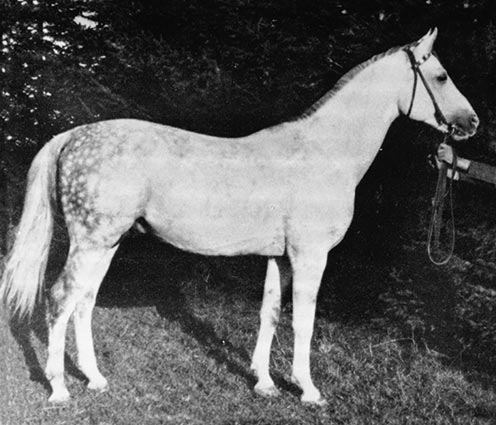
AMURATH 1881 – THE STALLION OF THE CENTURY
Even if King Charles’ interest was not so much focused on purebred Arabian breeding, it was during his term that the ‘stallion of the century’, Amurath 1881, was born. His dam was the above mentioned Koheil III 1876, his sire was Tajar 1873 (Tajar 1862/Obeja 1862), also bay of 152 cm withers height and a very well-proportioned stallion, only his slightly flat knee and the steep and short pastern on his front legs could be criticised. His son Amurath 1881 was used at stud from 1885 to 1895 and left behind a number of excellent daughters, which dominated the broodmare band at the time. However, only one of his sons, Selim 1896, was used for breeding but only for a short time. When most of the younger mares of the stud were daughters of Amurath, there was no longer use for the sire and he was sold to Radautz (Romania) in 1895. There, we can read about him in the stallion register: ‘light fleabitten grey, with snip to the right, born in 1881, measures 163 cm (tape), 177 (girth), 20,6 cm (cannon). A beautiful, well-proportioned stallion, as it is very rarely found, with good, beautiful, noble body conformation, strong and correct legs, and very good flat movements. He has a very good and lively temperament despite his age, he is very docile, trusting and a good stud. He was bought on 29th March 1895 by the k.k. Agricultural Ministry from the Royal Private Stud of Weil in Württemberg for 3000 Austrian Gulden. From 25th April to 10th May 1905 he got laminitis on both front legs. On 12th December 1910 he died of old age.’
Also in Radautz, Amurath 1881 became famous as a ‘sire of broodmares’. In Weil, all his colts had been sold – the last of this line was his grandson Nana Sahib I 1918 – and so the very existence of the Bairaktar sireline hung on a silk thread. The bottle neck, through which the Bairaktar-line had to go (genetically speaking), was the Radautz-bred purebred Arabian stallion Amurath II, who – when sold to Poland - got the name of 35 Amurath II (out of Fatme Or.Ar.). Only through his son Amurath Sahib (out of Sahiba, a great-granddaughter of Amurath 1881 through Nana Sahib I) and by fortunate circumstances, the line continued.
But Amurath Sahib, just like many of his ancestors, sired better mares than stallions, and so only three colts went into breeding: Equifor, Arax and Gwarny, of which Arax was sold to Russia and Gwarny remained in Poland. Both continued the Bairaktar sireline in their respective countries. In the 1990s, the State Stud Marbach, which had taken over the horses of Weil Stud in 1932, attempted to re-introduce the Bairaktar-line with the Polish stallions Pasat, Penthagonn and the Germanbred Pamir I (by Penthagonn). This experiment was successful and the two chief sires Dschehim and Said are the best examples. Unfortunately, after the untimely death of Dschehim, Said seems to be the last stallion of the Bairaktar sireline through the Polish branch which at the same time tails back to the damline of the foundation mare of Weil, Murana I Or.Ar.
While the Polish representatives of the Bairaktar-line were rather feminine, and resembled the Saklawy type, the Russian part of the Bairaktar-line is quite different in its phenotype, as the dam of Arax, the mare Brda (from Bábolna) seems to have been predominant. From now on, the Russian representatives of the Bairaktar-line (Arax - Nabeg - Menes, etc.) were closer to the Kuhaylan type, which is what the Russians preferred anyway. The most significant branch is carried by Nabeg and Menes to Balaton, the ‘Stallion of the Century’. His son Kubinec has propagated this branch in Germany, much more than Neman (by Nabeg) who was imported before. But Kubinec’s most significant son was bred in Bábolna: Nabila B, out of Elf Layla Walayla, a straight Egyptian mare. El Nabila’s show career started in Germany, and continued with the Brazilian and US National Champion titles. Due to his dam’s influence, he belongs to the more refined Saklawy type. At 23 years old, El Nabila B (at the time if writing) is preparing to enter the ring in the US Nationals, quite possibly the eldest stallion to compete for the title, and testament to the enduring qualities of this bloodline.

BAIRAKTAR’S BLOOD IN WARMBLOOD BREEDING
When we leave purebred Arabian breeding and turn towards Shagya- Arabian breeding, we find some offspring of Amurath 1881, who got a name in Warmblood breeding of various different countries, eg. with Amurath I 1898 (out of 314 Gidran XXIV) in Hannovarian breeding. Amurath I was widely used and six of his sons were breeding stallions at Celle, where you can find his blood through Amulett II and Amateur I, among others, in the pedigree of Gotthard (*1949), a famous sire of show jumping horses.
Another stallion, Amurath II 1896 (out of 248 Shagya V), ended up in Schleswig-Holstein. Here, he had 11 licensed stallions, in Lower Saxony three, in Trakehnen one. But he also had a certain influence on Dutch Warmblood breeding, and so the Olympic horses Hickstead and Valegro carry Amurath blood.
However, the most significant influence on European sport horse breeding was through the famous sire of show jumpers, Ramzes (*1937). He had Amurath 1881 twice in his pedigree - and Bairaktar 28 times - through his dam, the Shagya-Arabian mare Jordy. Ramzes founded a true sport horse dynasty and many horses whose name start with ‘R’ trace back to him: Retina under Fritz Thiedemann, Romanus with Hans-Günther Winkler in the saddle and Ramona with Alwin Schockemöhle. They all wrote equestrian history and furthered the fame of Ramzes in Holstein. The strain of Ramzes was later split into two branches: From Holstein, the Raimond-Ramiro-branch spread and stamped show jumping worldwide. Today’s show jumpers such as Rubinstein, Rock Forever or Cornet Obolensky – he is said to carry Bairaktar more than 100 times in his pedigree – they all have Ramzes among their ancestors. From Westphalia, the Radetzky-offspring through Remus I-Romulus I-Romadour II prevailed, but this time in dressage: Remus with Harry Boldt, Mariano with Dr. Josef Neckermann and Tiga with Heinz Lammers in the saddle. It is a phenomenon that is true ‘til today: Ramiro Z stands for show jumpers, while Radetzky stands for dressage horses, but all carry Ramzes and with him Amurath and Bairaktar in their pedigrees. Ramzes was considered one of the most influential sires of the postwar era. And thus, the genes of a rather small, but most significant desertbred Arabian from the Syrian desert are still present in the most important sport horse breeds of the world.

